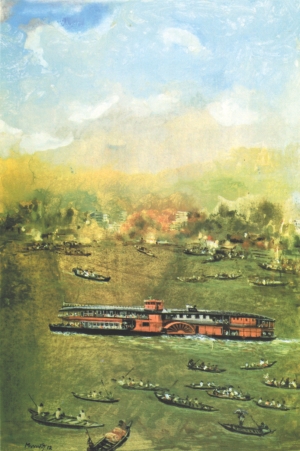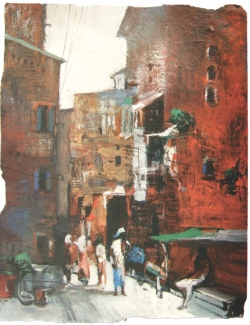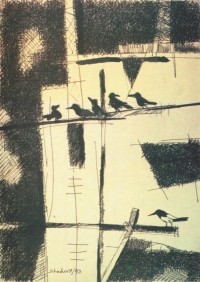| Home - Back Issues - The Team - Contact Us |
 |
| Volume 11 |Issue 30| July 27, 2012 | |
|
|
Reflections Recalling Old Fayza Haq
Visiting Mala and Madan dada several times in Old Dhaka, at Tipu Sulta Road, near Wari, sure was an experience. The cats in their house, Shantrashi, Lalu, Kanu and the lot, were huge and listened to every word the wife uttered, as if they were trained students. The monkeys outside were like the ones I'd seen before in Kanpur in India, where my mother lived with my two elder brothers before 1947. The monkeys still reside in Old Dhaka in all their past glory, where there are mosques, mandirs and churches. The Armenian Church is something special; I have visited it several times, with my friends, and taken photographs, and made sketches or tracings of graves. I used to go there with my friends, at times, to sings hymns during Christmas and Easter. Interviewing people connected with the Church was also interesting. Now everything seems to have become derelict. Going to Boro Katra and Choto Katra were adventures too. Actually the house in which Mala stayed was splendid – with alcoves, pillars, ledges, balconies, balustrades arches one saw in the house once owned by the photographer Anwar Hussain, who now lives in France, and comes to Dhaka keep in touch with his old friends. I used to visit Old Dhaka, in connection to paining exhibitions or to buy old silver or even some small gold items for family weddings, decades back, that is, when gold and silver ornaments were affordable for very close relatives; such visits were made with delight – talking to goldsmiths, and silver smiths and choosing the silver patterns of ornate chokers, balis and earrings, years and years ago. Dhaka
There were cobbled streets, horse and carriage transportation, trips to the Buriganga River with artist friends, and markets where residents bought their fish and veggies. Oh, nostalgia, contended memories of happier days of sunshine and birds chirping. There were not the cement jungles that confine us today. There were gardens, parks, flowers and variegated potted plants on balconies and terraces. This was the world where I played and studied in my childhood, at St Frances School with cousins at St Gregory's or Pogos or Notre Dame College, across the narrow lanes of Old Dhaka. And the old State Bank building was there, with its potted plants, to read endless books on lazy summer days; days that were full of dreams, hopes, songs and dances. One learnt about bakarkh-anis, guria ki shadi and traveling salesmen with ribbons, lace, bangles and bales of cloth from fathers who grew up in Old Dhaka, and so spoke Urdu at home, with one learning smatterings of Persian too, as a rule. It was essential for fathers, who longed to visit Europe, to bring back books on art – Dutch and Spanish masters like Rembrandt, Goya, and books from the Tate Gallery instead of fancy clothes, watches and the likes. Vincent Van Gogh, Matisse and the French Impressionists were loved by young ones, like myself, when one had art and book loving parents in Old Dhaka. More so by little girls who shared their grandfather's encyclopedias and sepia picture books with visiting cousins. It was in the libraries of Old Dhaka, when elder brothers were away doing science experiments that one read novels meant for older readers. It was during occasional visits to the grandfather's house when one was a resident of Old Dhaka that one gobbled grown up matters in older aunts' magazines. Borrowed books at that time, like the “Teen Digest” helped one grow up too.
When my grandmother sold her diamond nose ring, it was to send my dad to an Urdu speaking family, where bakarkhani and gurya ki shadi along with jatras were no big deals. Everybody, who was anybody, had some connection, sometime, somewhere with Old Dhaka. This included well-known creative people – painters, writers, singers or actors. That was where the famous addas were held – where books were bound – and second only to Calcutta and places like Shantiniketan. Lalbagh Fort and Pari Bib's tomb were not far away. Full of mosques, temples and churches, Old Dhaka could speak of the Muslim past and the wealth of the Moghuls – with pigeons and kites in the skies to carry messages of romance as important as any in Lahore or Delhi. Sher –shaeri were matters one heard of as a teenager. Dance, drama, and musicality were matters which were a must, just like seeing, and breathing. But memories of Rose Garden, the long, colourful boats on the Buriganga, the kite flying contests, the many buildings of Old Dhaka, with Victorian, and colonial architecture, and dreams and hopes of traveling to far off places such as Afghanistan, and the Khyber Pass were elements cooked up in one's readings of Old Dhaka— years back.
|
||||||||||||
Copyright
(R) thedailystar.net 2012 |


